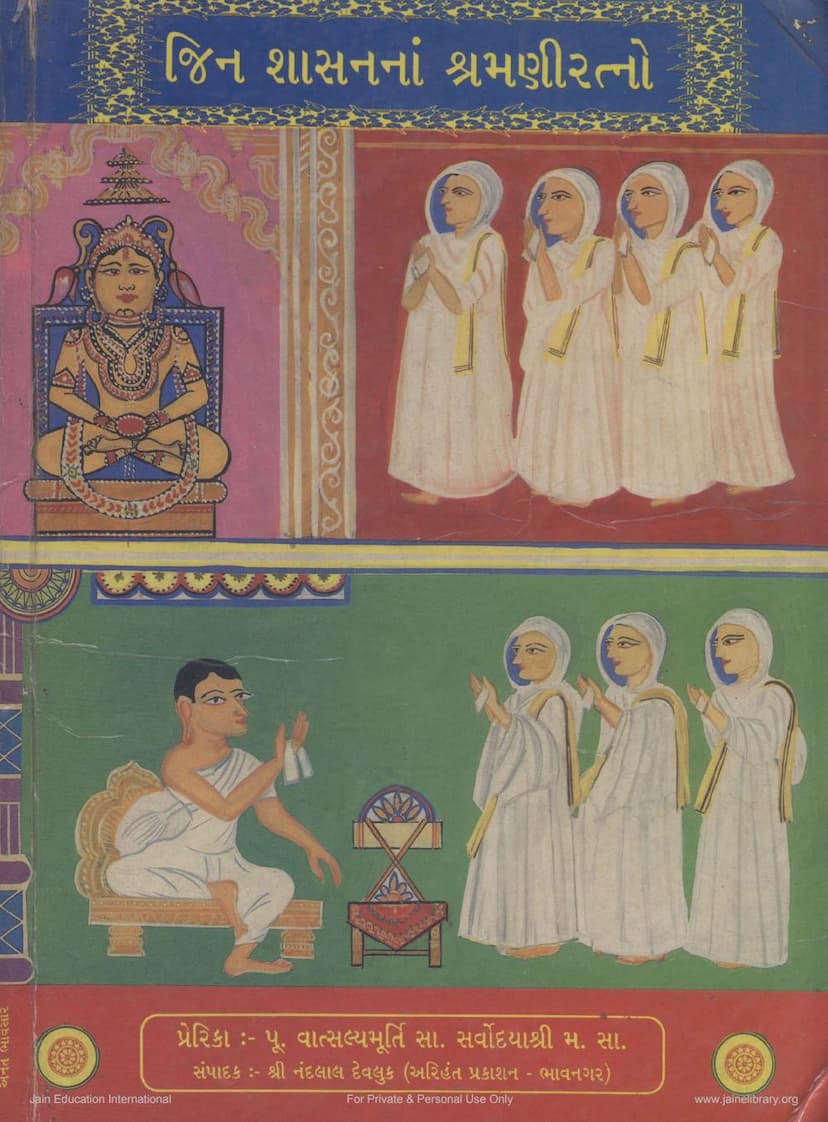Jin Shasanna Shramani Ratno
Added to library: September 2, 2025

Summary
The book "Jin Shasanna Shramani Ratno" (Jewels of the Jain Ascetics) by Nandlal B Devluk, published by Arihant Prakashan, is a comprehensive collection dedicated to the lives and contributions of Jain ascetics, specifically focusing on the female ascetics (Shramanis) within the Jin Shasan (Jain tradition). The catalog link provided is https://jainqq.org/explore/005131/1.
The book aims to bring to light the invaluable role of these women in preserving, propagating, and enriching Jainism. It highlights their dedication, knowledge, ascetic practices, and exemplary conduct as guiding lights for future generations.
Here's a breakdown of the key themes and content, as gleaned from the provided snippets:
Core Theme: The central theme of the book is to honor and document the lives of eminent Jain female ascetics, referred to as "Shramani Ratno" (Jewels among Ascetics). It emphasizes their significant contributions to the Jain faith, often in parallel with their male counterparts, the ascetics (Shramanas).
Content and Structure: The book appears to be structured chronologically and thematically, covering:
- Historical Overview: It delves into the history of Jain ascetics, starting from the earliest times, including the pre-historic era, and tracing their lineage through the eras of Tirthankaras like Lord Rishabhdev, Lord Parshvanath, and Lord Mahavir.
- Ascetic Principles and Practices: The text discusses the strict codes of conduct (achars) followed by Jain ascetics, including their dietary regulations (ahara), rules regarding clothing (vastra) and vessels (patra), daily routines (dinacharya), disciplinary procedures (dand prakriya), the essence of their ascetic life (sanyamjeevan ki saramayata), and the specialized boundaries of their discipline (sanyam palan ki vishisht maryadao).
- Biographies of Prominent Ascetics: A significant portion of the book is dedicated to biographies of numerous Jain female ascetics. These accounts highlight:
- Early Ascetics: Mentions of ascetics from the time of Lord Rishabhdev, like Brahmi and Sundari, are found.
- Ascetics from Mahavir's Time: Detailed accounts of prominent female disciples of Lord Mahavir, such as Chandanbala, Mrigavati, Priyadarshana, Yashodhara, and Yakshdutta, are presented.
- Historical Ascetics: The book chronicles the lives of many ascetics from the first century up to the eighteenth century, showcasing their intellectual prowess, ascetic feats, and dedication to the Jain path.
- Later Period Ascetics: It also covers ascetics from various gacchas (sects) and communities of the 19th and 20th centuries, often detailing their lineage under specific Acharyas like Anand sagar Suri, Shital tilak Hem-Tirth Shriji, Hir-Pushpa Shriji, etc.
- Contributions to Jain Literature and Culture: The book highlights how these ascetics were not only practitioners of rigorous asceticism but also scholars, writers, and preservers of Jain scriptures. Their role in imparting religious education, particularly to women, and in maintaining the purity of Jain traditions is acknowledged.
- Inspiring Virtues: The text focuses on virtues like renunciation (tyag), asceticism (tapasya), knowledge (gyan), meditation (dhyan), forbearance (sahanasheelata), compassion (karuna), humility (namrata), and unwavering faith (shraddha) demonstrated by these ascetics.
- Social and Spiritual Impact: The book underscores the profound impact these women had on society by reviving Jainism, fostering religious consciousness, and serving as role models for spiritual seekers, especially women.
- Dedication and Support: The book acknowledges the key individuals and institutions that supported the publication, including the inspirational guidance of Pujya Vatsalyaamurti Sa. Sarvodaya Shriji M. Sa., the editorial work of Shri Nandlal Devluk, and the publication by Arihant Prakashan.
Key Figures and Concepts Mentioned:
- Pujya Sarvodaya Shriji M. Sa.: Appears to be a significant inspirational figure for the book's creation.
- Nandlal Devluk: The editor and compiler of the book.
- Arihant Prakashan: The publisher.
- Various Acharyas and Munis: The text frequently mentions the guidance and inspiration from prominent Jain Acharyas and Munis.
- Key Ascetics: Figures like Chandanbala, Mrigavati, Yakshini Mahattara, Brahmi, Sundari, Rajamati, and many others are discussed.
- Gachhas: The book touches upon the different Jain sects or lineages like Kharatar Gachha, Achal Gachha, Tapagachha, etc., and their prominent female ascetics.
- Tapasya and Sadhana: The rigorous ascetic practices, fasting (upvas, ayambil), and meditation are emphasized as central to their spiritual journeys.
- Jain Scriptures: References to scriptures like Achara Sutra, Dasavaikalika Sutra, Sutrakritanga, Kalpa Sutra, Brihat Kalpa Bhashya, Gha's Niyukti, Pind Niyukti, etc., are made to support the information.
Overall Purpose: The book serves as a tribute to the noble lineage of Jain female ascetics, highlighting their spiritual achievements, intellectual contributions, and the enduring legacy they have left behind for the Jain community and beyond. It aims to inspire readers by showcasing the profound dedication and spiritual strength of these women who played a crucial role in the flourishing of the Jain tradition. The book is a testament to the fact that women in Jainism have achieved the highest spiritual states, including Keval Gyana (omniscience).